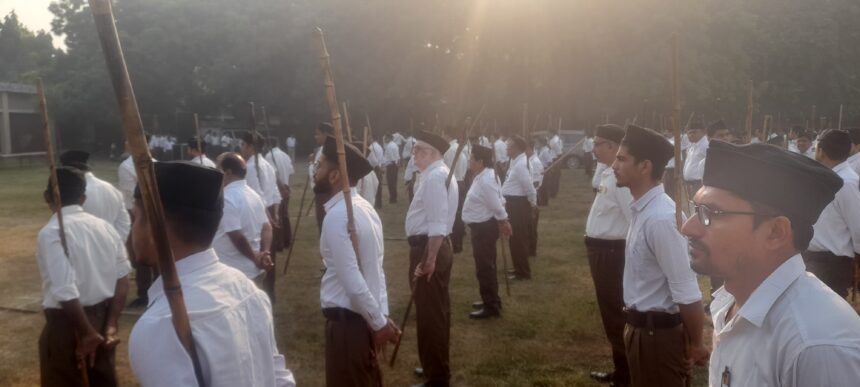Striving for Character Excellence: Enhancing Shakha Quality
Part 4: RSS Centenary Sankalp Blog Series
🇮🇳/🇬🇧
Introduction
Striving for Character Excellence is not a matter of numbers but of depth—discipline, dharma, and duty. The RSS centenary resolution emphasizes that shakhas must nurture confidence, values, and responsibility through training, prayer, and collective living. From individuals to families and society, this pursuit builds the foundation of a harmonious Hindu society for global peace.
Striving for Character Excellence Through Shakha Parformance
The centenary declaration of the Rashtriya Swayamsevak Sangh (RSS) in Bengaluru, 2025, outlined five transformative goals for the coming century. Among them, the second—Striving for Character Excellence—stands as the true heart of the resolution. Expansion in numbers alone, the declaration affirms, cannot create a harmonious and organized Hindu society capable of ensuring world peace. It is the pursuit of depth in character, cultivated through training, discipline, and dharmic values, that defines the Sangh’s vision for the next century.
The Meaning of Quality: From संस्कार to Collective Confidence
Striving for character excellence within the Sangh does not mean external polish or statistical achievement. It is about nurturing आत्मविश्वास—a collective self-confidence rooted in dharma. The centenary text emphasizes that Hindu society must perform its global duty effectively. That capacity will arise not from mere pride but from genuine understanding of our roots, our philosophy, and our civilizational responsibilities.
A second dimension of excellence is the building of संस्कारित जीवनशैली—a way of life aligned with values and conscious of its ecological impact. The RSS envisions families that are both environmentally harmonious and morally grounded. Finally, character excellence also implies सामाजिक दायित्व बोध—a consciousness of civic duty oriented toward the nation. Taken together, these three axes—confidence, values, and responsibility—form the essence of Striving for Character Excellence.
Branches as Laboratories of Excellence
The daily shakha is the testing ground where these ideals are practiced and refined. In the words of the declaration, “सभी प्रकार के भेदों को नकारने वाला समरसता युक्त आचरण” is the first visible sign of quality. A swayamsevak who walks into the shakha must rise above divisions of caste, region, or language and participate in shared discipline.
This character is further strengthened through the rhythm of everyday activities—prarthana, surya-namaskar, group songs, games, and intellectual discussions. Simple as they may seem, these practices cultivate teamwork, humility, and courage, gradually shaping personality traits that extend into family and social life. A shakha dedicated to striving for character excellence is therefore not merely a training ground but a microcosm of the harmonious society the Sangh seeks to build.
Training Initiatives: From Tradition to Modernity
The emphasis on character excellence is not left to theory. The Sangh has institutionalized numerous structured training programs. संघ शिक्षा वर्ग, उच्च स्तरीय प्रशिक्षण शिविर, and specialized leadership courses provide swayamsevaks with comprehensive exposure to physical, intellectual, and spiritual dimensions. Here, ancient practices of collective discipline meet modern methods of leadership development.
In recent years, digital initiatives—such as webinars and e-shakhas—have expanded the scope of quality training, ensuring that learning and character building remain accessible even in urban or global contexts where physical shakha attendance is difficult. These adaptations underline the flexibility of RSS in balancing continuity with innovation.
Leadership as the Expression of Excellence
The declaration highlights that striving for character excellence is inseparable from leadership development. True leadership, in the Sangh’s vision, rests on three pillars. The first is नैतिक नेतृत्व—a moral compass that safeguards society against divisive tendencies. The second is समाज बोध—the capacity to engage with contemporary questions and provide constructive solutions. The third is विश्व दृष्टि—a worldview expansive enough to present Hindu values as universal exemplars before humanity.
A swayamsevak who internalizes these traits does not remain confined to shakha activities but becomes a bearer of social responsibility, whether as a teacher, professional, community leader, or policymaker.
Measuring Character Excellence: From Individual to Society
The path of character excellence requires clear metrics. Improvement is visible when a swayamsevak displays samarasata in conduct, cultivates a value-oriented family life, and contributes actively to society’s welfare. Assessment is both personal and collective—through self-reflection, peer observation in the shakha, and the wider social impact visible in communities.
Addressing Contemporary Challenges
Modern India presents paradoxes: consumerism alongside spiritual thirst, individualism alongside the search for belonging. The centenary declaration recognizes these tensions and prescribes a balanced vision: “भौतिक समृद्धि एवं आध्यात्मिकता”. By anchoring modern skills in a dharmic foundation, the Sangh resolves the apparent opposition between tradition and progress.
Similarly, the global-local tension is addressed through the goal of विश्व शांति और समृद्धि. The Sangh’s mission is not inward-looking isolation but preparing Hindu society to engage constructively with the world, offering a civilizational response to global challenges.
Practical Pathways
On the individual level, striving for character excellence is achieved through self-study, service, and discipline. At the family level, it is visible in the nurturing of value-oriented homes and environmentally conscious habits. At the societal level, it manifests in transcending caste divisions, participating in service initiatives, and contributing to national strength.
These three concentric layers—individual, family, and society—form the living spiral through which the RSS seeks to build an organized Hindu society capable of being a model for the world.
Conclusion: Striving for Character Excellence as the Foundation of Global Responsibility
The second goal of the centenary declaration reminds us that expansion without depth is hollow. The true foundation of the Sangh’s future lies in Striving for Character Excellence—a path that transforms individuals, families, and society, ultimately enabling India to stand as a beacon of harmony before the world.
As the resolution itself declares, the task is to create a society rooted in samarasata, sustained by value-based families, and committed to civic duty. It is through Striving for Character Excellence that the prayer “सर्वे भवन्तु सुखिनः” can move from being a chant to becoming a lived reality.
Feature Image: Click here to view the image.
Video
Glossary of Terms
-
Shakha (शाखा): Daily local gathering of Rashtriya Swayamsevak Sangh members for physical exercise, prayer, discipline, and training in cultural values.
-
Samarasata (समरसता): The principle of harmony that transcends caste, region, and language divisions, ensuring equality and unity in conduct.
-
Swayamsevak (स्वयंसेवक): A volunteer of the RSS who participates in shakhas and community service, striving to embody dharmic discipline and character.
-
Prarthana (प्रार्थना): The daily RSS prayer recited at shakhas, encapsulating the mission of unity, strength, and service for society and the nation.
-
Surya-namaskar (सूर्यनमस्कार): A sequence of yogic postures performed to honor the sun, widely practiced in shakhas for health, discipline, and synchronization.
-
Sangh Shiksha Varg (संघ शिक्षा वर्ग): Intensive RSS training camps designed to provide physical, intellectual, and spiritual education to swayamsevaks at various levels.
-
Uchch Stariya Prashikshan Shivir (उच्च स्तरीय प्रशिक्षण शिविर): Advanced training camps of RSS where selected swayamsevaks undergo rigorous instruction in leadership, strategy, and social responsibility.
-
Dharma (धर्म): In this context, not religion but the eternal principle of cosmic order, moral duty, and righteous living forming the foundation of Hindu civilization.
-
Sarve Bhavantu Sukhinah (सर्वे भवन्तु सुखिनः): A Sanskrit prayer meaning “May all be happy, may all be free of illness,” used as a universal dharmic invocation for peace and welfare.
-
विश्व दृष्टि (Vishwa Drishti): A worldview or global perspective that enables the Hindu society to present its civilizational ethos as a universal model for humanity.
#Excellence #Character #RSS #HinduinfoPedia #Shakha
Previous Blogs of the Series
Related Blogs
- https://hinduinfopedia.org/rashtriya-swayamsevak-sangh-a-pillar-in-modern-hindu-society/
- https://hinduinfopedia.org/sanatana-dharma-secular-and-inclusive-values-of-hindu-philosophy/
- https://hinduinfopedia.in/nathuram-godse-murderer-patriot-or-fractured-youth/
- https://hinduinfopedia.org/ambedkars-buddhist-political-move-divergence-from-gandhi-on-caste-issues/
- https://hinduinfopedia.org/india-china-border-tensions-a-strategic-analysis/
- https://hinduinfopedia.in/gandhis-murder-was-nehru-involved/
- https://hinduinfopedia.in/waqf-act-debate/
- https://hinduinfopedia.com/abrahamic-religions-alliance-how-global-networks-target-indias-democracy/#Modi_the_RSS_and_the_Abrahamic_Narrative_Trap



Leave a Reply